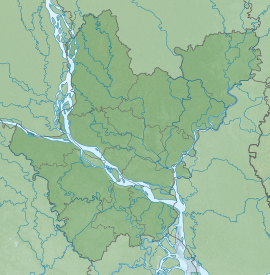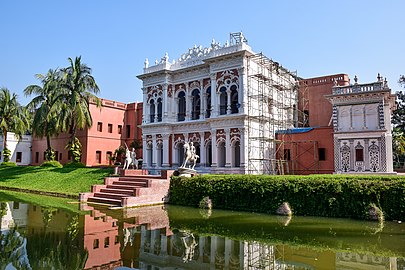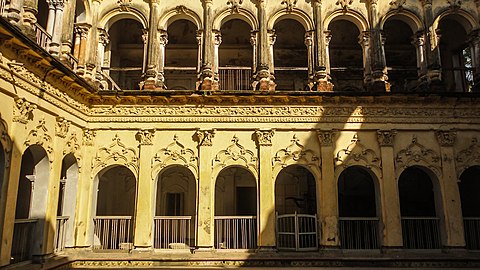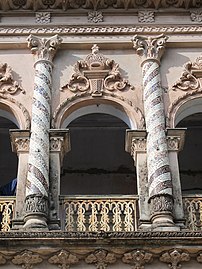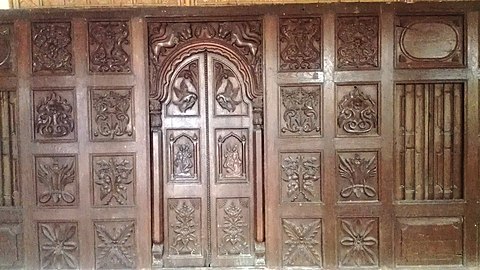Sonargaon
সোনারগাঁও | |
|
From top:Goaldi Mosque, Shilpacharya Zainul Folk Arts & Crafts Museum, Panam Nagar, Panam Nagar Architecture, Neel Kuthi, Taj Mahal Bangladesh | |
| Location | Narayanganj District, Dhaka Division, Bangladesh |
|---|---|
| Coordinates | 23°38′51″N 90°35′52″E / 23.64750°N 90.59778°E |
| History | |
| Founded | Antiquity |
| Abandoned | 19th century |
Sonargaon (
Sonargaon is one of the old capitals of the historic region of
Sonargaon gained importance during the
Sonargaon draws many tourists each year in Bangladesh. It hosts the Bangladesh Folk Arts and Crafts Foundation, as well as various archaeological sites, Sufi shrines, Hindu temples, and historic mosques and tombs.
History
Antiquity
Sonargaon is located near the old course of the Brahmaputra River. To the north of Sonargaon are the Wari-Bateshwar ruins, which archaeologists have considered to be the emporium (trading colony) of Sounagoura mentioned by Greco-Roman writers.[2] The name Sonargaon originated with the ancient term of Suvarnagrama.[3] Sonargaon was ruled by Vanga and Samatata Kingdoms during antiquity. The Sena dynasty used the area as a base. The Deva dynasty King Dasharathadeva shifted his capital from Bikrampur to Suvarnagrama in the middle of the 13th century.[3] Sonargaon is also one of the possible locations for the fabled land of Suvarnabhumi that is referred in cultures across the Indian subcontinent and Southeast Asia.

Delhi Sultanate (13th and 14th centuries)
Muslim settlers first arrived in Sonargaon circa 1281.
Sonargaon began to develop as a seat of Muslim learning and
Sonargaon Sultanate (14th century)
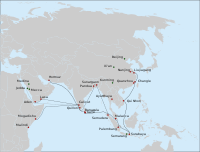
The Sultanate of Sonargaon became a short-lived independent state with control over central, northeastern and southeastern Bengal. When Bahram Khan died in 1338, his armour-bearer,
Bengal Sultanate (14th, 15th and 16th centuries)

The three city-states of Bengal were unified into an independent sultanate. There was a decisive break from the authority of Delhi. Sonargaon became one of the major townships in the eastern part of the Indian subcontinent. It was a strategically important river port with proximity to the Brahmaputra Valley and the Bay of Bengal. The third Bengali Sultan Ghiyasuddin Azam Shah established a royal court in Sonargaon. The township flourished as a center for writers, jurists and lawyers. The vast amount of Persian prose and poetry produced in Sonargaon during this period has been described as the "golden age of Persian literature" in Bengal.[8] The Sultan invited the Persian poet Hafez to the Bengali court in Sonargaon. The institutions founded by Abu Tawwama were maintained by his successors, including the Sufi preachers Saiyid Ibrahim Danishmand, Saiyid Arif Billah Muhammad Kamel, Saiyid Muhammad Yusuf and others.[7]
During the 15th century, the Chinese
During the
Sonragaon hosted a
Twelve Bhuiyans (late 16th and early 17th centuries)
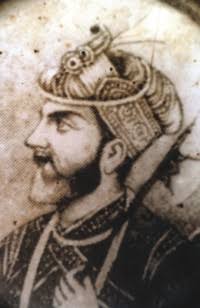
Under Sultan
In the Ain-i-Akbari, Abul Fazl wrote about the "fine Bengali war boats" of Isa Khan's navy.[16] In the Akbarnama, Abul Fazl stated "Isa acquired fame by his ripe judgment and deliberateness, and made the twelve zamindars of Bengal subject to himself".[17] Isa Khan used the Jangalbari Fort. In 1578, the Twelve Bhuiyans defeated Mughal viceroy Khan Jahan I under the leadership of zamindars Majlis Pratap and Majlis Dilawar, after Isa Khan was forced to retreat during a battle on the Meghna River.[18] In 1584, following an invasion by Shahbaz Khan Kamboh, Isa Khan and Masum Khan Kabuli launched a successful land and naval counterattack in Egarosindur on the banks of the Brahmaputra River, which repulsed the Mughal invasion.[19] In 1597, Isa Khan's navy dealt a massive defeat to the Mughal Navy on the Padma River. The Mughals were led by viceroy Man Singh I, who lost his son in the battle. Isa Khan's navy had surrounded the Mughal fleet on four sides.[20]
In 1580, the English traveler
Isa Khan died in September 1599. His son,
Mughal rule (17th and 18th centuries)
Sonargaon was one of the districts (sarkars) of Mughal Bengal. The Mughals built several riverside fortifications near Sonargaon, as part of defences for the provincial capital Dhaka against
- Mughal structures in and around Sonargaon
-
A 17th-century Mughal bridge over a decaying canal
British rule (18th, 19th and early 20th centuries)
During
- Panam City

Modern era
The Bangladesh Folk Arts and Crafts Foundation was established in Sonargaon by Bangladeshi painter Zainul Abedin on 12 March 1975.[4] The house, originally called Bara Sardar Bari, was built in 1901. On 15 February 1984, Narayanganj subdivision was upgraded to a district by the Government of Bangladesh.[24]
A sub-district of Narayanganj District, formerly named Baidyabazar was renamed as Sonargaon. Due to the many threats to preservation (including flooding and vandalism), Sonargaon was placed in 2008 Watch List of the 100 Most Endangered Sites by the World Monuments Fund.[25] The present-day Sonargaon is a municipality in Narayanganj District.

Trade
Sonargaon was an ancient center of
- Crafts and art of Sonargaon
Demographics
At the time of the 2011 census, Sonargaon Municipality had 7,289 households a population of 32,796. 6,952 (21.20%) were under 10 years of age. Sonargaon had a literacy rate of 62.57% and a sex ratio of 951 females per 1000 males.[29]
See also
- Gauda (city)
- Pandua, Malda
- Mosque City of Bagerhat
References
- ^ ISBN 81-206-0451-2.
- ^ "A Family's Passion". Archaeology Magazine.
- ^ a b c d e Muazzam Hussain Khan, Sonargaon Archived 4 March 2016 at the Wayback Machine, Banglapedia: The National Encyclopedia of Bangladesh, Asiatic Society of Bangladesh, Dhaka, Retrieved: 21 January 2012
- ^ ISBN 978-984-33-2004-9.
- ^ a b ABM Shamsuddin Ahmed, Shamsuddin Firuz Shah Archived 4 March 2016 at the Wayback Machine, Banglapedia: The National Encyclopedia of Bangladesh, Asiatic Society of Bangladesh, Dhaka, Retrieved: 21 January 2012
- ^ Khan, Muazzam Hussain. "Ghiyasuddin Bahadur Shah". Banglapedia. Retrieved 27 July 2015.
- ^ a b c d e f "Sonargaon". Banglapedia.
- ^ a b "Persian". Banglapedia.
- ISBN 0-321-08443-8
- ^ a b Muazzam Hussain Khan, Fakhruddin Mubarak Shah Archived 2 July 2015 at the Wayback Machine, Banglapedia: The National Encyclopedia of Bangladesh, Asiatic Society of Bangladesh, Dhaka, Retrieved: 23 April 2011
- ^ "Alauddin Ali Shah". Banglapedia.
- ^ "Ibn Battuta". Banglapedia.
- ^ Muazzam Hussain Khan, Ikhtiyaruddin Ghazi Shah Archived 4 March 2016 at the Wayback Machine, Banglapedia: The National Encyclopedia of Bangladesh, Asiatic Society of Bangladesh, Dhaka, Retrieved: 21 January 2012
- ^ ABM Shamsuddin Ahmed, Iliyas Shah Archived 4 November 2016 at the Wayback Machine, Banglapedia: The National Encyclopedia of Bangladesh, Asiatic Society of Bangladesh, Dhaka, Retrieved: 21 January 2012
- ^ a b "Goaldi Mosque in Sonargaon". Dhaka Tribune. 22 December 2019.
- ISBN 978-81-8400-776-3.
- ^ Chisti, A.A. Sheikh Md. Asrarul Hoque (October 2013). The Bara-Bhuiyans and Their Times: A Study of the local anti-Mughal Resistance in Bengal (1576-1612 A.C.) (PDF) (PhD). University of Dhaka. Archived from the original (PDF) on 16 September 2016.
- ^ "Isa Khan". Banglapedia.
- ISBN 978-0-8108-8024-5.
- ISBN 978-0-520-20507-9.
- ^ Ryley, J. Horton (John Horton) (1899). "Ralph Fitch, England's pioneer to India and Burma; his companions and contemporaries, with his remarkable narrative told in his own words". London, T.F. Unwin.
- ISBN 978-0-520-20507-9.
- ^ Feroz, M A Hannan (2009). 400 years of Dhaka. Ittyadi. p. 12.
- ^ Md Solaiman, Narayanganj Archived 7 March 2016 at the Wayback Machine, Banglapedia: The National Encyclopedia of Bangladesh, Asiatic Society of Bangladesh, Dhaka, Retrieved: 21 February 2012
- ^ "2008 World Monuments Watch List of 100 Most Endangered Sites" (PDF). World Monuments Fund. Archived from the original (PDF) on 20 March 2013. Retrieved 27 July 2015.
- ISBN 9788185579566.
- ^ Ryley, J. Horton (1899). "Ralph Fitch".
- ^ "Bangladesh Population and Housing Census 2011 Zila Report – Narayanganj" (PDF). bbs.gov.bd. Bangladesh Bureau of Statistics.
- ^ "Community Tables: Narayanganj district" (PDF). bbs.gov.bd. Bangladesh Bureau of Statistics. 2011.
Further reading
- Kazi Azizul Islam and Tania Sharmeen (5 July 2005). "Panam Among World's 100 Endangered Historic Sites". News from Bangladesh.
- Roy, Pinaki (9 July 2004). "Panam Nagar's Fate in Limbo". The Daily Star.
- Ali, Tawfique (26 April 2007). "Unscientific Restoration Defacing Heritage". The Daily Star.







